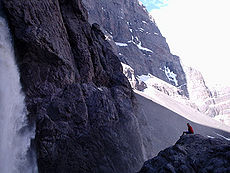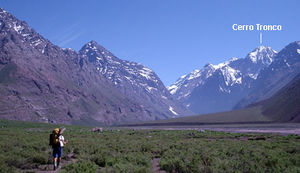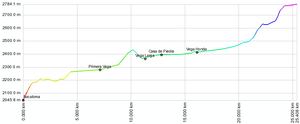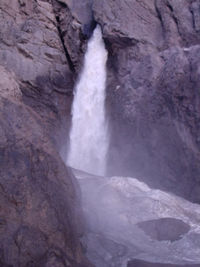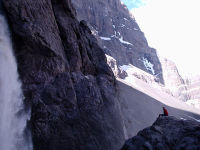ENG:Gran Salto del Río Olivares
|
|
|
| |||||||||||||||||||||||||||||||||||||||||||||
General description
The national heritage route, which is part of Sendero de Chile "Andes Centrales: Río Olivares Gran salto is a wonderful alternative for excursion lovers and is only 86 km. away from Santiago This route is now open to the public thanks to the funds and support of the Ministry of National Heritage, by means of their program Rutas Patrimoniales and CONAMAs (National Environmental Committee) program Sendero de Chile which allows a pedestrian access to the central mountain range, together with a written guide so travelers may enjoy their trip in a safe and well informed manner. The mountain trail is 27 km long, and requires at least four days of relaxed walking. This is recommended not only for security reasons but also to allow the traveler to have enough time to enjoy the natural scenery. Along the way one can also find suitable camping sites. During the excursion, the traveler will be rewarded with high-andean landscapes, beautiful rock formations, snowed peaks, evidence of ancient glaciers, waterfalls and the superb flight of the condor, in one of the pristine and purest valleys of this central mountain range.
Location and access
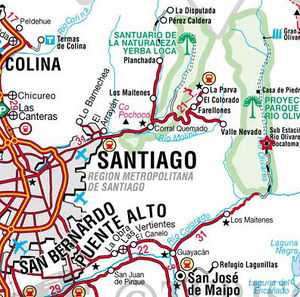
Olivares River-Gran Salto Patrimonial Road is located 86 km North-East Santiago, following road G- 25 Cajón del Maipo to the East, until Río Colorado crossing, taking then Road G- 345 Cajón del Colorado, to the North-East, until the location of El Alfalfal. Access to the road from the location of El Alfalfal is restricted at Gener S.A. control, having to request prior authorization to the Ministry of National Property. After recording entry at the control barrier, there are 7 km of double lane gravel road, parallel to Colorado River by the North, until reaching the first detour, taking alternative road to the left, the access to Olivares River basin. At this point starts a 12 km tour to the North, with a maximum 400 meter unevenness through a one lane road, along Olivares River border, and climbing a little slope until reaching Olivares River intake, corresponding to Gener S.A.s Olivares Sub-station. The road starts in a little detour to the left, just before arriving to intake facilities, specifically, at coordinates 394604 E / 6303570 N. Such road is bounded in the North by Gran Salto del Olivares, in the East by Olivares River, in the South by Olivares Intake, and in the West by Cordón del Cepo. Olivares River-Gran Salto Patrimonial Road is located North-East the pre-cordilleran location called El Alfalfal, district of San José de Maipo. It is a 27 km lineal road that recovers old paths used for mining, hunting, and cattle-raising activities, divided into four segments from Olivares River Sub-station, 2.050 meters above the sea level (Intake) to Gran Salto del Río Olivares, located 2.800 m.a.s.l. At least 4 days must be considered to complete the full round circuit, estimating days of 6 hours of continuous hiking, being also possible to ride a horse or mule, also considering in that case 4 days of 4 daily-hour riding. Summer and spring times are advisable in both cases for further security of the visitor. Alternatively, a cross country ski tour may be considered, specifically, in the first three segments at the beginning of spring time.
Main atractive
aspects of Olivares River-Gran Salto road are: Plain Vegetation and Shrub Formation at Heights: It is possible to observe 4 plain formations of interesting configuration, which are connected to the presence of crystal water springs enabling development of vegetation and their use as supply and camping areas. These are: "Primera Vega", "Vega Larga", "Vega Casa de Piedra", and "Vega Honda". It is also possible to identify several species proper to elevated environments, many of them with therapeutic usage. Among the more commonly found flora in the road, we can mention Pingo Pingo, Junelia, Lengua de Gallina, Añañuca, Paihuén, Chacai, Rubilla, among others. Fauna: Condors is the most spectacular specie to observe. It can be seen both individually and in groups of 4 or more birds, flying close to the level of the ground, looking for preys, in particular, at "La Morrena" sector. It is also usual to have the presence of other birds: a variety of big finches, crown sparrow, small partridge, a variety of pheasant, and swallow, that can be seen in flatter sectors related to plains or stream and river beds. Geomorphy of the Landscape: Inside Olivares River basin, it is possible to observe a wide variety of geomorphy derived from plate tectonics, a complex faulting system, and erosive processes connected to quaternary glacial activity, specially referred, in the last case, to abrasion exercised by glacial bodies on the bedrock, the biggest glacial unit in the central Andean cordillera, and resulting from avalanche and snow melting phenomena, allowing to obtain a singular configuration of the main valley. We can highlight development of a number of outfall fans, among which such located in the East sector of El Bordón slope, in Primera Vega and Vega Honda, are the most important. Cascades: A number of cascades of very different sizes, that may be specially seen at the end of spring time and at the beginning of summer time, among which El Bordón stream, Los Castaños and Gran Salto falls of Olivares River may be highlighted for their panoramic scenario. Casa de Piedra (House of Stone): It is a lytic structure of both anthropologic and historic interest, without specific data on its origin; however, it is directly connected to activities carried out since remote times; first, camelidae hunting, and then, since the colony, occupation of summer pasture and as a traffic place connected to Las Pircas" or "Fraile crossing point.
Signaling
Design of marks implemented in the field is based on a French experience of hiking road signage. It is a pioneer system in this ambit, and world-wide recognized for its efficiency and simplicity. This signaling has been complemented by the Ministry of National Property with a numerical system connected to points of special interest, which we call SNUPIE (Spanish abbreviation for Points of Special Interest Numeric System). These Snupies are represented by Arabic numbers and have their own meaning, since they support geographic interpretation of the road. The road is made up by 25 points of interest (SNUPIES) and 105 marks, both of them geo-referenced of road indication and direction, using 1 meter high rock monoliths as signaling support, in order to use local materials with minimum impact. Distance between marks is variable, being frequently kept within walkers sight, disposed at a distance of no more than 400 meters, in view of which slow walk for over 15 minutes without any monolith visualization would mean possible detour from the road.
First segment
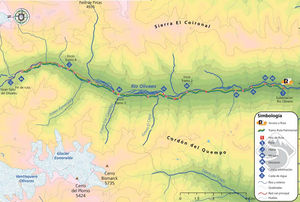
Degree of Difficulty: Easy to little difficult. Basic raid apt for family tour. Precaution at La Morrena sector for exposure in steep edge. Type of Terrain: Bottom of valley and stable wavy hillsides, erosion in main scarp, with well marked track. Abundant shrub sparse vegetation. Description of the Segment: The tour starts at Olivares River Intake (Olivares River Sub-station), SNUPIE No. 1, where an esplanade is located used as a parking lot, from which the old road is taken in a 116 meter slight slope until reaching a dry-stone wall with a signal of detour to the left. Then, there is a slightly more elevated gradient through a well marked track climbing the so-called La Morrena" sector, parallel to Olivares River scarp, making sure to keep prudent distance from the cliff, until reaching the high part of SNUPIE Nº 2. Here you may have a panoramic view of the valley, condors flying, mountain ranges that make up Olivares River basin, Cepo mountain range, Sierra del Coronel, and Esmeralda hill; as well as watching an interesting outfall fan system that shapes the bottom of Olivares River valley longitudinal axis. Underground natural bed of Olivares River can also be admired in this sector, covered with ice and colluvial material of East hillsides, a natural phenomenon explaining multiple constructions of dams in the valley. After SNUPIE Nº 2, there is a descent followed by a slight hilly ground gradient, until arriving to SNUPIE Nº 3 from which it is possible to observe shrub sparse vegetation: Paihuén, Lengua de Gallina and Rubilla. It is a high sector, which is ideal for watching Olivares River valley and the majestic flight of condors, specially concentrated in this segment of the road. Descent starts after SNUPIE Nº 3, passing by Laguna Seca (Dry Lagoon) through its East side (it is called dry lagoon for being a small depression with seasonal water accumulation that can only access until the end of sprig time), traveling a 200 meter plain terrain tour. Pay attention not to miss the track in the middle of this abundant shrub vegetation. The tour continues taking general course 0º and having Esmeralda hill as a natural reference milestone, until reaching SNUPIE Nº 4, where you can rest or camp. This site is protected from winds and from potential floods. There, you can see strata existing in the opposite spring cone, helping to understand evolutional dynamics inherent to outfall fans and their differentiation in stratified cuts of chaotic composition. From this last point, you may continue by Olivares River to easily cross a stream constituted by two arms. After crossing the second arm, the track is lost, reason why you have to head North starting to go down to Ventanas stream, crossing the delta of this stream, until arriving to a small plain that is ideal to camp and quite protected from North winds, corresponding to SNUPIE Nº 5. The site has crystal water at 50 meters, and its identification is clear, since the opposite spring is made up by flashy yellow lands. The edge of the upper terrace is taken from SNUPIE Nº 5, having crossed between two small bumps as a reference point, to turn then East until arriving to a plain sector, the branching point of the path. Take alternative road to the left and walk 200 meters until SNUPIE Nº 6, South of Las Ramadas stream, a place with access to the water and a wide panoramic view of the valley. The road continues until the main track is lost in several secondary branch roads, having to cross an approximately 200 meter depressed and muddy terrain. There is a continuity mark on an isolated rock to be used for reference purposes. The walk continues in dry land, heading West, progressively approaching Olivares River along a 1.5 kilometer segment until reaching the edge of this river terrace, from which Primera Vega can be seen, SNUPIE Nº 7. To access this "Primera Vega", it is necessary to go down to Olivares River bank, walking first along this river bank and then, the small plain in its East end about 270 meters to arrive to crystal water springs. SNUPIE Nº 7 is an ideal place to rest and then continue to the plain called Casa de Piedra or to come back to spend the night. Be prepared, since this place is not well protected against South winds. End of segment 1.
Second segment
Degree of Difficulty: Easy to little difficult. Basic raid for family tour. Precaution at El Bordón slope for exposure in inclined hillsides. Type of Terrain: Bottom of valley, with wavy to stable steep hillsides. Floodable sector of plains and active gorge at El Bordón slope. Well marked track. Abundant shrub sparse vegetation. Description of the Segment: Plain terrain has to be followed from walking along Olivares River main erosion gully. You have to be cautious, since the track is divided into several branch roads. After 500 meters of walk from the beginning of this segment, you will have to cross another active colluvium cone, where the track is lost. In consequence, the limit between rocky soil and sandy soil has to be followed. 1.2 kilometers North SNUPIE Nº 7, take stony terrain by Olivares River main terrace, starting a slight slope with a front view to the El Bordón stream waterfall. Keeping the edge of the terrace and progressively deriving to the West, you will arrive to SNUPIE Nº 8, an observation and panoramic view site where you can observe both El Bordón stream waterfall and Olivares River. You have to pay special attention between this point and El Bordón stream, since the track is lost in small segments. It is advisable, after passing between two clearly identifiable hilly grounds, to take the big rock by El Bordón stream crossing as a reference point, corresponding to SNUPIE Nº 9, a good place to access water before starting El Bordón slope, with views to the waterfall of such stream. During thawing period (November to January), special attention must be paid when crossing the stream. It is recommended to look for natural passages some meters upstream or to schedule the crossing before noon, especially in good weather days, during December and January. You will keep on climbing, keeping Esmeralda hill as a reference point, until reaching SNUPIE Nº 10, that indicates a change of direction to the left. Be cautious because this terrain is steep, with possible falling rocks at Quebrada Seca crossing. You will continue along a small deflation to the right, in an approximately 100 meter segment, to continue then along a clear track to subsequently reach SNUPIE Nª 11, the highest point of the slope and natural mirador from which it is possible to observe formation of Lomas Coloradas stream outfall fans and Olivares River valley in its lower and upper segment, specially, flats at Olivares River banks that constitute the so-called Vega Larga". SNUPIE Nº 11 origins progressive descent of the slope through firm land. After 320 meters, the slope ends and approach road to Vega Larga begins. Take course 20º until arriving to the bifurcation corresponding to SNUPIE Nº 12. The right hand track leads to "Vega Larga", located at Olivares River banks, and such of the left, continues along the main path, heading to "Casa de Piedra" plain. "Vega Larga" plain SNUPIE Nº 13 is an appropriate place to make a stop before continuing with the last part of the segment. It is a place for camping slightly exposed to South and North winds. From the SNUPIE Nº 13 take course to 30º and go up to a small terrace and immediately derive to the left having as reference the waterfall of El Cepo stream (in front). After a small slope you must go through a land with sparse degraded vegetation and without track, reason why it is necessary to take course to 340º, having as reference an isolated rock with orange-colored moss, where both tracks meet again at 220 meters of "Vega Larga plain. From the intersection, move 300 meters until reaching El Cepo stream, where - on its right branch - it is possible to observe a rock with an arrow. From there, you should cross the stream downstream depending on the flow, which shows an important variation during the day. After crossing El Cepo stream, the path branches off again. If you want to go directly to Vega Casa de Piedra plain, then take the alternative to the left. It is advisable to take the variant to the right, which after running 60 meters through dunes, leads you to an interesting natural mirador of Olivares river valley SNUPIE Nº 14. From this place, you have a full panoramic view of Vega Casa de Piedra plain and typical metamorphic rock strata from the Colimapu Formation (Lutitas strata) to the North-East. From there, you go down to the active delta of the North branch of El Cepo stream to cross it, keeping as reference the South end of "Vega Casa de Piedra" plain until reaching the plain as such. From this point, you should border on the plain around its West edge about 200 meters in order to meet the direct access track to Vega Casa de Piedra plain. It is advisable to cross a small plain sewage channel to go round the edge of it through its East and North-East end. The land is flat, dry and without track for about 750 meters until reaching the SNUPIE Nº 15 besides a spring and dry- stone walls. it is an appropriate location to take a break and observe the landscape. It is advisable to camp and visit the "Casa de Piedra" plain located at 250 meters to the North, and considering an interesting place of shelter, used centuries ago by hunters, smugglers and muleteers of the zone. Finish of Segment 2.
Third segment
Degree of Difficulty: Easy. Basic excursion, familiar walk. Precaution by crossing Los Castaños and Esmeralda streams for lost of track. Type of Land: Background of stable valley, highly stony roads by crossing streams and possibly flooded in plain sectors. The track marked is weak. Abundant sparse shrub-like vegetation. Description of the Segment: From SNUPIE Nº 15 go round the edge Vega Casa de Piedra plain through its Northern end to continue ern besides Olivares River following the track in flat terrain until Vega Seca plain. In this last point it is possible to see the frontier path route Las Pircas or Del Fraile, used for centuries to historically connect Hacienda de Las Condes farm through El Cepo stream with the province of Mendoza in the Republic of Argentina. The path continues by the edges of said plain until reaching to a small temporal stream to the South of Los Castaños stream, where the outfall fan of Mil Hojas gorge begins in the opposed spring. Continuing with the tour, you go round the edge of the West river bed of Los Castaños stream, where it is possible to appreciate its waterfall and move forward through flat land until reaching a small plain, crossing it through the East edge for about 250 meters leading to its North end. You must be precautious in this sector since the track is not marked. Take course to 16º going round the edge of Olivares River until reaching to SNUPIE Nº 16, obtaining at this point a wide panoramic view of the waterfall of Los Castaños stream and the upper valley of Olivares River, mainly from the area of Vega Honda plain. In this sector you have access to water and immediately continue to cross the stream and begin a slight downward slope until reaching Olivares River and access the South end of Vega Honda plain after running 600 meters until the SNUPIE Nº 17. From this location you can have access to water, plan a short break, admire the landscape of the environment or just camping. Be careful by reaching the rocky cliff on the West edge of the plain due to loosening danger. Take into consideration that there are no locations protected against winds. From the SNUPIE Nº 17 follow the stone line of the East end of the plain, do not enter the plain since they are lands absolutely impassable, unstable and not recognizable. it is advisable to take as reference Tronco hill and go round the edge of said plain for about 800 meters until reaching to its North- West end besides a brook. Afterwards, you begin running through stony lands without track going round the edge of
an outfall fan until facing Esmeralda l stream. From this point, you should oint, continue between the scarp and the West river-bed of Esmeralda stream without crossing it for 1.4 kilometers until reaching the SNUPIE Nº 18, at 50 meters of its crossing. From the SNUPIE Nº 18 it is possible to observe the waterfall of Las Pircas stream, with access to water and where the delta crossing begins through stony sector without track and with approximation to the high moraine in a 1.7 kilometer segment, finally remounting said moraine through its East end. Take course to 48º from the beginning of the tour at a moraine base level until reaching to a small climb that leads to a stone monolith in the highest part of the moraine SNUPIE Nº 19. It is an ideal location for camping between the biggest rocks protecting you from winds and freezing of the lower sector; in addition, at a few meters you will have access to water. Finish of Segment 3.
Fourth segment
Degree of Difficulty: Slightly difficult-difficult. Half mountain excursion requiring speed skills. Precaution in certain sectors where the track disappears as a result of the stone deflation. Possible dehidratation in slope sectors. Type of Land: Valley background and unstable steep hillsides with presence of outfall fans and main rocky terrace with no marked track. Poor sparse shrub-like vegetation. Description of the Segment: From SNUPIE Nº 19 continue the tour immediately downstream taking y course to 45º to a gorge through stony roads without track, crossing it and rack, taking as reference Tronco hill. You nce must be precautious since from autious SNUPIE Nº 19 there is no well-marked track.. After moving forward 715 meters, you enter a plain land sector without track, composed by erosion materials partially obstructing the run, especially when riding. You reach to the SNUPIE N° 20, which is located at about 10 meters from the Olivares River river- bed. it is a location where you can see geological formations, and in particular, the contrast between West and East hillsides of the main valley, basically referred to tectonic composition and deformation of hillsides, observing stratum dipping over 65º in the West sector. The road continue going round the edge of Olivares River for 350 meters until reaching to the beginning of the second slope, leaving aside Olivares River. The track is weak, reason why it is necessary to follow the visible dry-stone walls leading to SNUPIE Nº 21. This SNUIPIE is an appropriate place for camping or to take a break. The access to water is at approximately 100 meters. The location is slightly exposed to South winds. This is the last site where you can have access to water, except for spring seasons where you could access to a stream without name at 3.3 kilometers from the SNUPIE N° 21. It is not advisable to consume water from Olivares River due to its high turbidness. The tour continues through a small climb with course to 0º until arriving to SNUPIE Nº 22. In this location you could appreciate a wide panoramic view of the Olivares River valley until "Vega Honda" plain sector by the South and a small 240 meter segment of Blanca gorge with crossing of 50 meters of snow land patch for the beginning of the season (November- January). Surpassing said gorge, you continue climbing without track, being extremely careful of not surpassing course 350º due to the presence of cliffs of more than 100 meters high, reason why it is recommended to take course to the West going round the edge of said cliff at a prudent distance, especially in low visibility conditions. After moving forward 350 meters climbing is finished and an abrupt downward slope of 200 meters begins through marked track of loosen soil with slopes ranging between 40º and 45 º. It is a contact zone between cliffs and colluvial material of West hillsides. It is required to be extremely precautious due to the high exposure to fall of rocks in the downward slope which come from the hillside, reason why it is not advisable to make stops in said downward slope. From the end of the downward slope, the road is projected through the flat land of the upper terrace of Olivares River, going round the edge of scarp keeping the same terrace level. it is a tour of approximately 950 meters of rocky land between the hillside limit and the terrace scarp with no significant development of a stable soil allowing a comfortable running, resulting from the lack of track forcing to look for a better choice. Note the predominance of an dominance incipient cover of Pingo-Pingo as Pingo-Pingo floristic species which must be observed. A sector slightly exposed to avalanches in spring seasons. At the end of this segment, you enter an esplanade corresponding to a fluvial terrace of Olivares River where it comes. From this point, you should take flat stony land and without track for 180 meters until the beginning of the third slope ( SNUPIE Nº 23 ). SNUPIE Nº 23 is located in the last flat sector before reaching to Gran Salto del Olivares mirador. it is not a location proper for camping due to its exposure and lack of water. Thus, it is conformed as a starting point of the third slope, comprised by a great 600 meter zigzag climb through firm and mb marked land with elevation difference h of 150 meters. The hillside slope to be he remounted reaches 40º slightly exposed es to possible fall of rocks. f After arriving to the upper part of the slope, at more than 2,700 m.s.n.m., take general course to 300º, crossing through a flat sector with weak marked track between big rocks, beginning later with a pronounced closeness slope to Rinconada stream, arriving to SNUPIE Nº 24 besides the stream, ideal site to take a short break and access to water after remounting the third slope, which in spring time and early summer is slightly turbid at peak-fusion time. From SNUPIE Nº 24 continue going round the edge of Olivares River until facing a large split rock next to the river, which must be remounted by the left side through a small 50 meter climb. Go down until reaching the same level of Olivares River throughout its edge through land without track for about 300 meters until reaching a finishing point of deflation and begin the last part of the road. In the future, you should have as reference the top of Rabona hill in 550 meters until finally reaching SNUPIE Nº 25 at 200 meters to the West of Olivares River, where it is possible to have a wide panoramic view of Gran Salto waterfall of Olivares River and source of the Olivares River basin comprised by rocky cliffs reaching 1,000 meter high. At this point, it is possible to appreciate interesting geoforms of glacial genesis, such as the different front and lateral moraine levels resulting from the advance and reverse dynamics occurred during the last century and that have caused an important abrasive action of the mother rock, mainly related to the sector of Juncal Sur glacier. The site is not appropriated for camping due to the lack of water and as it is highly exposed to North winds. It is advisable to properly schedule the hours for return, if it is intended to continue the tour to the approximation to the Gran Salto waterfall of Olivares River. In general, it is recommended to return during the same day due to the lack of adequate sites in this last segment. Finish of Segment 4 and road.
Recomendations
Before starting, it is necessary to:
- Request prior entry authorization to the Ministry of National Property.
 This trek is very well described in the Rutas Patrimoniales guide from the Ministerio de Bienes Nacionales Digital Version, PDF version. It is also posible to ask for a printed version in the Ministery: 3512100, anexo 2325. It is highly advisable to take it to the trek, since it improve the experience with flora, fauna, geography and geology descriptions.
This trek is very well described in the Rutas Patrimoniales guide from the Ministerio de Bienes Nacionales Digital Version, PDF version. It is also posible to ask for a printed version in the Ministery: 3512100, anexo 2325. It is highly advisable to take it to the trek, since it improve the experience with flora, fauna, geography and geology descriptions.- Take warm and water-proof garments.
- Take food.
- Take a first aid medicine chest.
- Take a map of the path and elements for orientation.
- Take UV sunglasses and sun skin protective lotion.
- Get informed of weather conditions for better planning of the raid.
===Basic Recommendations===
- Try to make the tour accompanied and informed.
- Take into account duration of segments so that you may finish before it grows dark.
- Walk along the signaled road, do not leave the path.
- Come back if weather conditions grow worse.
*Do not throw garbage into the nature, bag it and take it back.
- Camp only in signaled sites.
- Do not light fire. If it was unavoidable, turn off the fire with abundant water.
- Do not hunt or disturb existing native fauna
To see the full list of 691 routes of trekking and mountain climbing in Chile in spanish, click here
| ||||
| Trekking Atacama | ||||
| Trekking Norte Chico | ||||
| Trekkings: | ||||
| Cumbres: | ||||
| Trekkings: | ||||
| Cumbres: | ||||
| Trekkings: | ▲ ENG:Gran Salto del Río Olivares ▲ ENG:Glaciar San Francisco / Monumento Natural el Morado ▲ ENG:Glaciar del Morado | |||
| Cumbres: | ||||
| Trekkings: |
| |||
| Cumbres: | ||||
| Trekking Rancagua | ||||
| Trekking San Fernando | ||||
| Trekking Curicó | ||||
| Trekking Talca | ||||
| Trekking Linares | ||||
| Trekking Chillán | ||||
| Trekking Concepción | ||||
| Trekking Los Angeles |
| |||
| Trekking Zona lacustre | Trekking Temuco | |||
| Trekking Valdivia | ||||
| Trekking Osorno | ||||
| Trekking Puerto Montt | ||||
| Trekking Chiloé | ||||
| Trekking Patagonia | Trekking Chaitén | |||
| Trekking Coyhaique | ||||
| Trekking Cochrane y Villa O`Higgins | ||||
| Trekking Puerto Natales | ||||
| Trekking Punta Arenas | ||||
| Trekking Tierra del Fuego | ||||
| Trekking Isla de Pascua | ||||
| Trekking Archipiélago Juan Fernández | ||||



